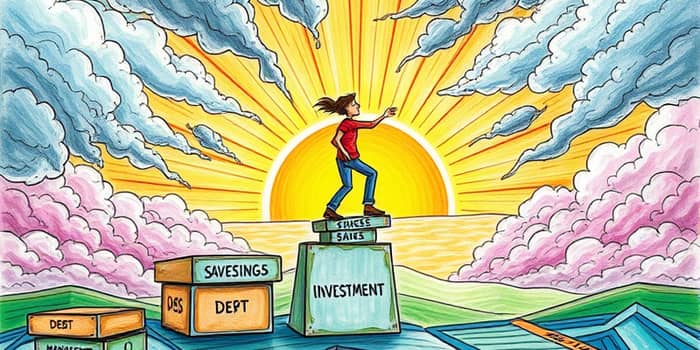When economic conditions feel unpredictable, it is natural to worry about maintaining stability. Yet, with thoughtful planning and proactive measures, individuals and small businesses can emerge stronger. This guide offers an inspiring and practical path forward.
Understanding the Economic Landscape
Global events, policy shifts, and market volatility have combined to create an atmosphere of precautionary reductions in spending and tightened credit. Households are now grappling with an average debt load exceeding $100,000, while small-business optimism has declined sharply. Consumer confidence is wavering, signaling that many fear a recession and are drawing in their financial sails.
Faced with rising interest rates, banks have grown more cautious about lending. Investors are shying away from high-risk ventures. In this environment, traditional forecasting feels unreliable. Yet, history shows that downturns can also unveil opportunities—for those who remain prepared, adaptable, and informed.
Core Principles of a Resilient Financial Strategy
- Build and maintain liquidity by setting aside three to six months of expenses in easily accessible accounts.
- Aggressively manage debt by targeting high-interest, variable-rate obligations first.
- Prioritize essential expenses and pause non-critical purchases until the outlook becomes clearer.
- Diversify across asset classes—equity, bonds, gold, and cash equivalents—to cushion against market shocks.
These principles are not mere suggestions; they form the bedrock of a strategy that can weather storms. By consciously focusing on emergency fund recommendations, you create a buffer that allows you to make calculated decisions rather than reactionary ones when volatility strikes.
Long-term investors should continue disciplined contributions through mechanisms like SIPs (Systematic Investment Plans), which harness market dips to buy assets at lower prices. Avoid the temptation to average down on underperforming holdings based on emotion; instead, adhere to a well-defined plan that emphasizes long-term investment strategies and sector resilience.
Securing Capital and Building Business Resilience
For entrepreneurs and small-business owners, economic uncertainty often translates into tougher borrowing conditions. Banks demand stronger credit profiles and may impose stricter covenants or higher rates.
- Explore government-backed loans and grants designed to stabilize businesses during downturns.
- Consider alternative financing such as crowdfunding, angel investors, or revenue-based financing models.
- Engage financial expertise by consulting fractional CFOs or financial coaches to uncover new funding avenues and optimize cash flow.
Delaying major capital expenditures can also improve your flexibility. If an investment yields uncertain returns in the short term, it may be wise to wait. Maintaining a strong cash position empowers you to act swiftly when favorable opportunities arise, such as acquiring distressed assets at discounted prices.
Importance of Financial Literacy and Strategic Planning
Today’s reality places greater responsibility on individuals to manage their own financial destinies. Social safety nets and traditional pension schemes are evolving, requiring a deeper understanding of risk, opportunity, and portfolio construction.
Building financial literacy can be transformational. Familiarize yourself with budgeting tools, investment basics, and tax strategies. Techniques like tax-loss harvesting strategies can offset gains and improve after-tax returns. By staying current on policy changes and economic indicators, you can anticipate shifts and adjust your plan proactively.
Actionable Steps and Checklist
- Gather complete financial records: assets, liabilities, and recurring obligations.
- Create a prioritized list of spending goals, with dates and target amounts.
- Build or replenish your emergency fund, even if it means automating small contributions.
- Pay off high-cost debts first, focusing on variable-rate loans.
- Pause non-essential expenses and delay large purchases until clarity returns.
- Maintain disciplined investing through downturns, avoiding emotional trades.
- Diversify your portfolio to reduce concentration risk.
- Use hedging tools, such as stop-loss orders, if they align with your comfort level.
- Stay informed on shifting policies, interest rate movements, and economic forecasts.
Each step in this checklist can be tailored to your unique circumstances. The goal is to transform anxiety into informed action, empowering you to face uncertain times with confidence.
Remember: financial resilience is not built overnight. It is forged through consistent, thoughtful choices that balance risk and opportunity. By embedding these practices into your routine, you create a roadmap that guides you through both calm and stormy periods.
Economic uncertainty may never fully disappear, but you can control your response. Let this comprehensive strategy serve as your compass, helping you navigate complexity, seize opportunities, and cultivate lasting peace of mind.
References
- https://economictimes.com/markets/stocks/news/strategies-for-retail-investors-to-survive-in-uncertain-markets/articleshow/120225202.cms
- https://njaes.rutgers.edu/health-finance/difficult-times.php
- https://gfrc.uic.edu/the-government-finance-research-blog/improving-forecasting-techniques-in-uncertain-economic-times/
- https://preferredcfo.com/insights/how-to-secure-capital-in-times-of-economic-uncertainty
- https://www.investopedia.com/uncertain-economy-protect-finances-8759794
- https://time.com/7276190/economic-uncertainty-tariffs-recession/
- https://www.becu.org/blog/steps-to-plan-for-financial-uncertainty










